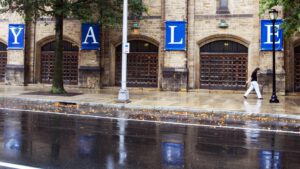- Amid teacher shortages, ADP’s Nela Richardson said it’s tough to get young people to enter the profession.
- A new ADP Research Institute report showed how teacher pay compares to the pay of all employees.
- Teacher pay as a share of the pay for all employees aged 20 to 25 has greatly fallen over the years.
Thanks for signing up!
Access your favorite topics in a personalized feed while you’re on the go.
download the app

There’s a shortage of teachers, and young adults could be shying away from the profession as teacher pay becomes less competitive.
That’s based on a conversation with ADP’s chief economist Nela Richardson and a new ADP Research Institute report by ADPRI principal data scientist Jeff Nezaj. The report highlighted the large contrast between employment and job openings for educators as well as how pay has looked for teachers.
The new report included a Competitive Salary Index based on ADP data comparing the salary of public and private school teachers to the average for all US workers. That ratio has notably declined since 2018 for those in their early 20s, a potential problem for Gen Zers looking to step into the education field after getting the necessary requirements to be a teacher.
Despite that relative decline, teachers are making more than they did before the pandemic; other jobs have just become much more lucrative. Data shared with Business Insider shows that teacher pay has increased from $42,971 in January 2018 for those aged 20 to 25 to $51,193 in October 2023 for those aged 20 to 25. And for teachers aged 25 to 30, that has increased from $49,427 in January 2018 to $59,780 in October 2023.
Richardson told BI “wages might discourage” young people “when they could make relatively more or see their salaries increase faster in other industries.”
“In the five-year period spanning 2018 to 2023, salary competitiveness eroded particularly for younger teachers, those aged 20 to 30,” Nezaj wrote in the ADPRI report. “This is a worrisome development, one that has the potential to create or exacerbate labor shortages by discouraging potential teachers from joining the profession.”
New data from the Bureau of Labor Statistics on Friday showed private education and health services saw average hourly earnings increase 3.8% from February 2023 to this past February, lower than the 6.6% increase for transportation and warehousing during that time, 5.9% for mining and logging, and 5.8% for financial activities.
Gen Z or other new teachers will need to help fill talent gaps in schools. There were 169,000 elementary and middle school teachers who were 65 years old or over in 2023 according to a table from the Bureau of Labor Statistics, and those older teachers may be looking to retire. The median age for elementary and middle school teachers was 43.1 in 2023, per BLS.
It’s not just the new report from ADP Research Institute that shows the problem with pay for teachers. An analysis published by the Census Bureau in 2022 also found teacher earnings have dropped and teachers — many of which had at least a bachelor’s degree — weren’t seeing the same pay as other jobs.
“Although teachers are among the nation’s most educated workers, they earn far less on average than most other highly educated workers and their earnings have declined since 2010,” the post said.
Schools already have experienced staffing shortages
Aaron Terrazas, chief economist at Glassdoor, previously said that “elementary and secondary schools tend to have a shortage of teachers” given licensing requirements and “lifestyle sacrifices” like low flexibility in terms of their schedule. Richardson noted the lack of location flexibility for teachers.
“There are some industries that are just not getting younger people to join because there’s better options post pandemic,” Richardson said.
Richardson said amid several positives that add up, including being in a job that’s rewarding, “you have to weigh that against lagging wages and less flexible working hours” when it comes to being a teacher.
“I think it is a challenge to get young people to come into that profession,” Richardson added.
But the problems in teaching, such as with pay and shortages, aren’t entirely new.
“This is a pre-pandemic phenomenon,” Richardson said.
For instance, she noted teacher strikes, such as one involving Denver teachers in February 2019 after over a year of negotiations. The Denver Classroom Teachers Association site said “educators have clearly expressed their vision for a fair, competitive and transparent salary schedule that prioritizes base salary over complicated, unreliable bonuses.”
“It was an industry that was clamoring for higher pay and you saw that on the ground,” Richardson said.
Teachers may also have to chip in for their own resources and supplies, adding to the financial strain of the job.
“I feel like a lot of teachers are expected to do their job without materials that they have or that they need,” one teacher previously said.
Teachers who worked during the pandemic also had to learn new practices, like implementing COVID safety and remote schooling.
“Teaching children — young children, high school students, middle school — remotely was challenging,” Richardson said. “And then when all these kids came back into the schools and they had to deal with all the social fallout from so many gaps in terms of peer-peer education, it was hard. It’s been hard. It continues to be hard.”
Education isn’t the only field that may have trouble attracting young job seekers.
Richardson said they seem to not be choosing to go into what she’s calling “the infrastructure field,” which she said included physical infrastructure jobs in fields like construction as well as social infrastructure like teachers and financial infrastructure like payroll specialists.
“More broadly, even past teachers, we’ve seen similar findings for nurses,” Richardson said. “So when you think about the care economy — an economy that allows working families to work by having teaching and healthcare resources — it’s not just about those particular professions. It’s about other professions that rely on, for example, early childhood education and teachers.”
Have you quit teaching or changed your mind about becoming a teacher? Reach out to this reporter at mhoff@businessinsider.com to share why and what job you are working now.


